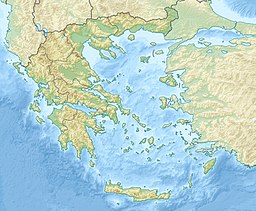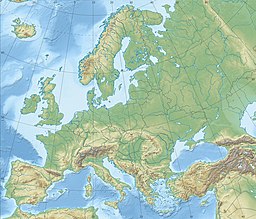
Albania is a country in Southeastern Europe that lies along the Adriatic and Ionian Seas, with a coastline spanning approximately 476 km (296 mi). Situated on the Balkan Peninsula, it is one of the most mountainous countries in Europe. It is bounded by Montenegro to the northwest, Kosovo to the northeast, North Macedonia to the east and Greece to the southeast and south.

North Macedonia is a country situated in southeastern Europe with geographic coordinates 41°50′N22°00′E, bordering Kosovo and Serbia to the north, Bulgaria to the east, Greece to the south and Albania to the west. The country is part of the wider region of Macedonia and makes up most of Vardar Macedonia. The country is a major transportation corridor from Western and Central Europe to Southern Europe and the Aegean Sea. North Macedonia is a landlocked country but has three major natural lakes: Lake Ohrid, Lake Prespa and Lake Dojran. It has a water area of 857 km2, while its land area is 24,856 km2.
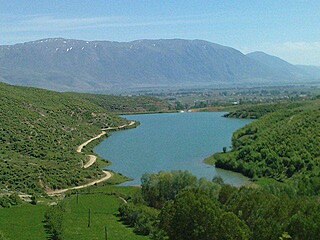
Korçë County, officially the County of Korçë, is a county in the Southern Region of the Republic of Albania. It is the largest by area and the seventh most populous of the twelve counties, with more than 202,000 people within an area of 3,711 km2 (1,433 sq mi). The county borders on North Macedonia to the northeast and Greece to the southeast, the counties of Elbasan to the northwest, Berat to the west and Gjirokastër to the southwest. It is divided into six municipalities, Korçë, Devoll, Kolonjë, Maliq, Pogradec and Pustec, with all of whom incorporate thirty-seven administrative units.

Lake Ohrid is a lake which straddles the mountainous border between the southwestern part of North Macedonia and eastern Albania. It is one of Europe's deepest and oldest lakes, with a unique aquatic ecosystem of worldwide importance, with more than 200 endemic species.

Doiran Lake, also spelled Dojran Lake is a lake with an area of 43.1 km2 (16.6 sq mi) shared between North Macedonia and Greece.

Prespa is a region shared between North Macedonia, Greece, and Albania. It shares the same name with the two Prespa lakes which are situated in the middle of the region. The largest town is Resen in North Macedonia with 9,000 inhabitants.

Galičica is a mountain situated across the border between North Macedonia and Albania. There is a national park on North Macedonia's side of the mountain, situated between the two biggest lakes in the republic: Lake Ohrid and Lake Prespa. It stretches over an area of 227 square kilometres (88 sq mi).

Prespes is a municipality in the Florina regional unit, Western Macedonia, Greece. Its population in 2021 was 1,211. The seat of the municipality is in Laimos. It was named after Lake Prespa, in the western part of the municipality.

Lake Skadar – also called Lake Scutari, Lake Shkodër and Lake Shkodra – lies on the border of Albania and Montenegro, and is the largest lake in Southern Europe. It is named after the city of Shkodër which lies at its southeastern coast. It is a karst lake.
Prespa is a region shared between the Republic of North Macedonia, Albania and Greece.

Agios Germanos,, is a village in the Prespes Municipality in West Macedonia, Greece. Agios Germanos is located at an altitude of approximately 1,040 m (3,410 ft), on a hillside, part of the Varnous Mountains. It is 7 kilometers (4.3 mi) from the Prespes lakes, which can be seen from a panorama location of the village. Agios Germanos lies 45 km (28 mi) from Florina, and 44 km (27 mi) from Kastoria.

North Macedonia, officially the Republic of North Macedonia, is a landlocked country in Southeast Europe. It shares land borders with Greece to the south, Albania to the west, Bulgaria to the east, Kosovo to the northwest and Serbia to the north. It constitutes approximately the northern third of the larger geographical region of Macedonia. Skopje, the capital and largest city, is home to a quarter of the country's 1.83 million people population. The majority of the residents are ethnic Macedonians, a South Slavic people. Albanians form a significant minority at around 25%, followed by Turks, Roma, Serbs, Bosniaks, Aromanians and a few other minorities.

Despite being a relatively small country, Albania is exceedingly rich in biodiversity. Its ecosystems and habitats support over 5,550 species of vascular and non-vascular plants and more than 15,600 species of coniferous and non-coniferous evergreens, most of which are threatened at global and European levels. The country has made recent efforts to expand its network of protected areas which now include: 11 national parks, 1 marine park, 718 nature monuments, 23 managed nature reserves, 11 protected landscapes, 4 World Heritage Sites, 4 Ramsar sites and other protected areas of various categories, that when combined, account for 21.36% of the territory. Furthermore, a biosphere reserve, 45 important plant areas and 16 important bird areas are found in the country.
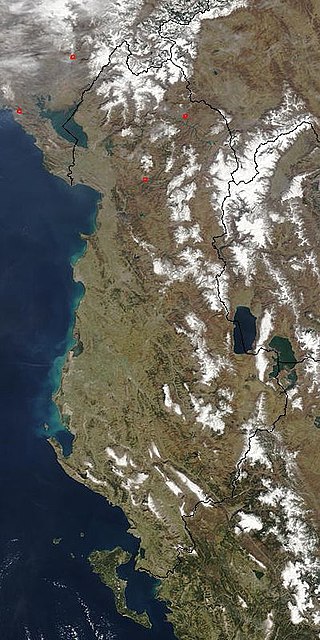
The Central Mountain Region is a physiogeographical region encompassing the central and eastern edge of Albania. It comprises the mountainous inland extending all the way from the valley of Drin and the mountains of Sharr, Skanderbeg, Korab, and Shebenik-Jabllanicë, through the lakes of Ohrid and Prespa, until it reaches the village of Ersekë and the mountains of Pindus close to the border between the country and Greece.

Small Prespa Lake is a lake shared between Greece and Albania. It is the smaller of the two Prespa Lakes.

Ohrid-Prespa Transboundary Biosphere Reserve is a biosphere reserve encompassing the area of Lake Ohrid and Lake Prespa, on North Macedonia and Albania.

Prespa National Park is a national park situated in southeastern Albania on the border triangle shared with Greece and North Macedonia. At approximately 277.5 km2 (107.1 sq mi), the park encompasses the country's sections of the Great and Small Prespa Lake. It is considerably characterised by high mountains, narrow islands, vast freshwater wetlands, salt marshes, meadows, reed beds and dense forests.

The Prespa Agreement, also known as the Treaty of Prespa, the Prespes deal or the Prespa accord, is an agreement reached in 2018 between Greece and the then-Republic of Macedonia, under the auspices of the United Nations, resolving a long-standing dispute between the two countries. Apart from resolving the terminological differences, the agreement also covers areas of cooperation between the two countries in order to establish a strategic partnership.

A referendum was held in the Republic of Macedonia on 30 September 2018, with voters asked whether they supported EU and NATO membership by accepting the Prespa Agreement between Macedonia and Greece, signed in June 2018, which aimed to settle the 27-year naming dispute, which had prevented Macedonia from joining both the European Union and NATO. Despite 94% of voters voting in favour, voter turnout was around 37%, less than the 50% threshold required to validate the results.
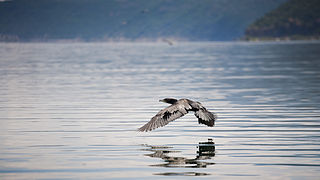
Over 22,500 species of wildlife have been recorded in North Macedonia. Over 10,000 of these are insects, which include 3,000 beetle species and large numbers of Lepidoptera, flies, and Hymenoptera. Aside from insects, other large arthropod groups include Chelicerata and crustaceans. Among vertebrates, more than 300 species of birds recorded, although not all nest in the country. There are over 80 species of both fish and mammals, 32 reptiles, and 14 amphibians.



